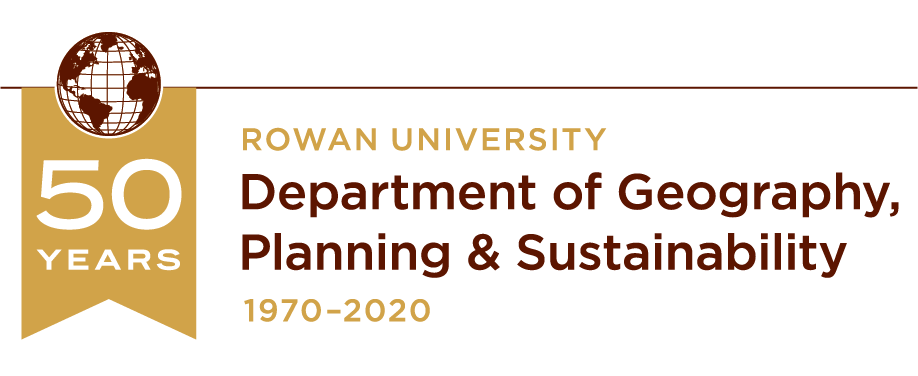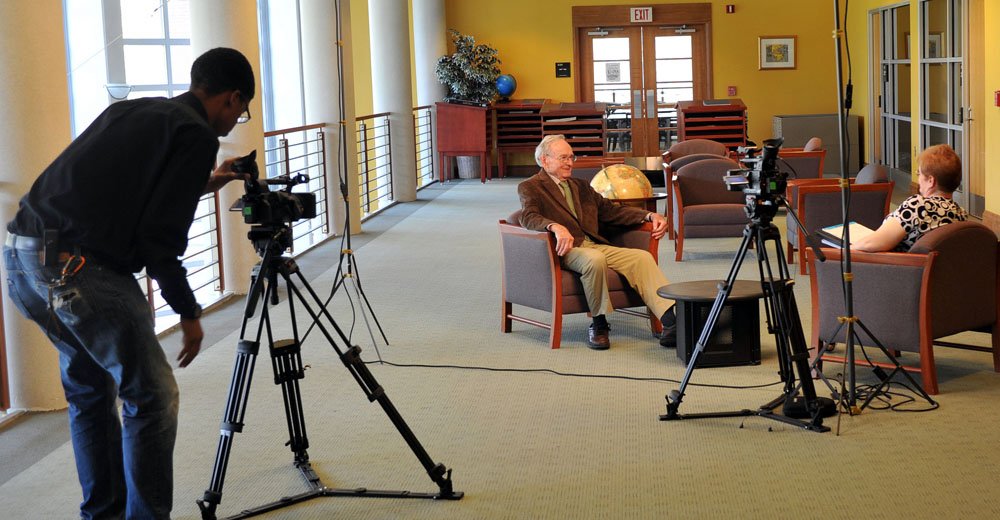Index
Index
The Department of Geography, Planning & Sustainability
History of the Department
The legacy of Geography education at Rowan University traces its roots to the institution’s earliest years when it was known as Glassboro Normal School. The first courses in Geography were offered as early as 1930—just six years after the first students arrived on campus—in the History, Geography, Penmanship, and Home Arts Department. Around 1934, a professorship of Geography was created, and Ethel Merriman became the first full-time geography faculty in Rowan’s history. In 1948, the Department of Social Studies was formed and taught classes in Geography, Anthropology and Sociology until 1969. Dr. Marvin Creamer, the second known geographer to be appointed at Rowan and the person who would later found the Geography and Anthropology Department, was hired into this department one year later in 1949.
In 1970, Dr. Marvin Creamer founded the Department of Geography and Anthropology at a time of uncertainty for both the study of the environment and the study of culture. The waning days of the colonial era caused some academics to deprioritize the study of culture, while the modern environmental movement - at least in the mainstream United States - was still in its infancy. With the false environmental utopia of suburban landscapes underway, the prospect of globalized societies only a distant dream, and the lasting impact of colonialism on people, culture, and place unimaginable, the need for a Discipline such as Geography that studies the underlying dynamics of the human in the environment seemed to some to be a luxury. In addition, in 1970, the Discipline of Geography found itself at an intellectual crossroads as it grappled with a past that focused on describing faraway places for colonial powers while university research shifted to scientific approaches aimed in part at defeating rising foreign powers. Add to these crosswinds the dissolution of Harvard’s Geography Department some twenty years before, in 1948, an action that was perceived by many to signal that Geography was not an academic subject suitable for the Ivy League even though Yale University established a Department of Geography in 1949; the outlook for Geography was further clouded.
Given this context, Dr. Creamer’s efforts to establish Geography at Glassboro State College back in 1970 may have seemed misguided. However, we now know his vision to have been prescient. What was not broadly known in 1970, was that suburban housewives were coming to understand the blight of human action on the landscape as their children - and eventually the women themselves - were sickened from malfunctioning septic tanks leaking in the backyard and the pesticides sprayed around their homes. These realizations were seeding, in part, a modern environmental consciousness that was poised to grow, with demands for knowledge reverberating and growing throughout the 1980s and 1990s into the 21st Century. The clamoring of people around the world under the weight of colonial lineages that seemed to ensure inequality and poverty was a whisper that turned to a roar, and those people demanded attention that in turn required knowledge of place and space. Finally, it is now known that the closure of Harvard’s Geography Department was due, in part, to the chairperson being gay, a decision that reflected not an academic assessment but rather revealed the last gasp of an intellectual system in the epicenter of U.S. higher education that was about to be transformed by a postmodern moment recognizing a variety of different perspectives.¹
It was at this moment that the University - under the guidance of Dr. Creamer - had the foresight to prioritize research and teaching about the environment, culture, and place.
The Glassboro State Department of Geography and Anthropology was created with six faculty specializing in Geography and three in Anthropology. The inaugural faculty members had unique research agendas ranging from the geography of wine, spatial distribution of adult entertainment establishments, and the State of New Jersey. Most notably, the founding department chair Marvin Creamer holds the record of being the first documented person in history to captain a sailboat in a circumnavigation of the globe without navigational instruments. Read more about Dr. Creamer here. This short video chronicles Dr. Creamer’s historic trip: https://www.youtube.com/watch?time_continue=2&v=nTFwnsjyhuA
Just as Dr. Creamer trusted his knowledge of the Earth to circumnavigate the planet without any modern technologies, he used this same knowledge to foresee a time when humanity would require a deep understanding of human-environment relationships, the focus of the Discipline of Geography. That time was 1970, and every year thereafter.
The department remained the Department of Geography and Anthropology until the College of Liberal Arts was reorganized into the College of Science and Mathematics and College of Humanities and Social Sciences in 2012. Around this time, Environmental Studies (an interdisciplinary program) needed an institutional home and the Geography curriculum seemed like a complimentary fit. With this earth-centric focus, and college-level reconfiguration, Anthropology formed a new department with Sociology and the department was renamed the Department of Geography and Environment.
In 2012, with encouragement from university administrators, a Geographic Information Systems (GIS) program was created within the department. Simultaneously, the Community and Environmental Planning program was created as an additional complimentary application of the geographical academic foundation of the department.
Another important part of the department’s history was marked by the 2016 creation of the School of Earth and Environment within the university. The Department joined this new school, which was founded and is currently led by world famous paleontologist and departmental alumnus Kenneth Lacovara. Two new departments in Environmental Science and Geology were created at this time that also became part of the School, as did the Jean and Ric Edelman Fossil Park. To clarify Departmental programs and contributions in the new school, , the Department of Geography and Environment was renamed the Department of Geography, Planning, and Sustainability.
At 50 years old in 2020, the Department continues to stay true to its founding goals of advancing an understanding of our world, the environment, and the people who impact both. The Department is forging strategic partnerships within the School of Earth and Environment, and with other departments on campus. In the early part of the spring 2019 semester, in preparation for a new strategic plan, the department defined a vision that will guide it over the next period of its evolution: The Department of Geography, Planning, and Sustainability is a leader in critical assessment and communication of human-environment relationships and sustainable community solutions.
The faculty and staff of the Department of Geography, Planning, and Sustainability, with the support of the School of Earth and Environment, Rowan University, its many alumni, and all of its key stakeholders and community partners, look forward to the implementation of this vision in the coming years!
1. Smith, Neil. 1987. Academic War over the Field of Geography: The Elimination of Geography at Harvard 1947-1951. Annals of the American Association of Geographers, 77(2): 155-172.

